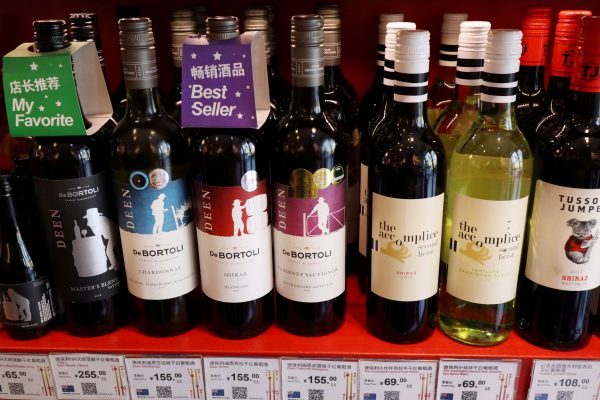The unwinnable war

China has unleashed a range of trade sanctions on Australia. Australian barley was hit with punitive tariffs of up to 80 per cent in June and more recently lobster from Australia has been left to rot as it waited to be inspected for quarantine. The latest casualty is Australian wine, now facing import duties of up to 212 per cent, affecting what is an AU$1.3 billion (US$900 million) a year market.
Australian barley was hit with punitive tariffs of up to 80 per cent in June and more recently lobster from Australia has been left to rot as it waited to be inspected for quarantine.
The trade and economic assault from China is a departure from the more targeted and opaque measures Beijing has deployed in the past. Chinese imports of Norwegian salmon collapsed after human rights activist Liu Xiaobo was awarded the Nobel Peace Prize in 2010 and Filipino bananas were left to rot in Chinese ports in 2012 over a South China Sea dispute.
The most blatant case was Chinese sanctions on South Korean retail, tourism and pop culture in response to the deployment of US Terminal High Altitude Area Defense (THAAD) missiles in South Korea to protect against North Korean missiles that were seen as a threat to Beijing.
Not all the examples are clear cut. Australian barley exports to China rebounded in July after the initial tariffs in June. A lot of Norwegian salmon found its way into China via Vietnam when it was blocked in China. Overall trade between South Korea and China grew during the sanctions and THAAD missiles are still deployed on South Korean soil. China may have a technical case against Australia’s Wine Equalisation Tax.
It is conventional wisdom to cite the restriction of rare earth element exports to Japan after a Chinese fishing trawler and Japanese coast guard vessel collided in waters near disputed territory as Chinese trade coercion.
Japan, the European Union and the United States won the case over the dispute at the WTO and China accepted the ruling. The sanctions of the strategically important resources were not aimed at Japan around one incident but were a series of export restrictions put in place to rein in the fragmented and environmentally damaging rare earth mining industry.
Unlike past cases of Chinese economic coercion that have gone unannounced, the assault on Australian exports suggests that Beijing is happy to make quite clear to Australia, and the rest of the world, its displeasure with Australia’s diplomacy towards it.
Deploying sanctions so blatantly and tying them to political disputes will raise the cost of doing business with China. China’s middle class is huge and growing rapidly but businesses trying to sell into that market will be less confident too. Other governments may put in place preemptive measures.
As the world’s largest trading nation, China has a huge stake in the open, rules-based trading system. It has just made significant concessions, like a negative list for foreign investment and signing up to East Asia’s Regional Comprehensive Economic Partnership (RCEP) agreement, the world’s largest trade agreement.
Much of the Australian commentariat is frothing at the mouth over the trade assault from China and those who wanted to diversify trade away from China are pleased Beijing is doing that for them — treating China as an enemy is turning China into one.
The Australian government has made the point clearly now that it will stand for its own interests and values and will not be bullied. Australia’s sovereignty is not for sale. But now Australia needs to find a way to manage its largest economic relationship. Self-defeating Chinese wolf warrior diplomacy and misguided economic policies provide Australia with no excuse for a race to the bottom.
Australia has made its fair share of blunders. Calling for an independent inquiry into the origins of COVID-19 ahead of any multilateral initiative looked like an assault on sovereignty from Beijing. Blocking yet another Chinese investment — from buying a Japanese dairy operation in Australia — on security grounds was another gratuitous affront to the Chinese.
A more confident and mature China might ignore such measures and get on with running the world’s second largest economy. But after China became the target of Trump’s America First agenda and growing hostility, Australia made itself an easy target on which to make a point.
As the world’s third most active user of protectionist anti-dumping measures behind the United States and India, Australia is far from the innocent, rule-abiding open trading nation many like to believe. The largest target of Australian anti-dumping measures by far has been China, with Australia putting punitive tariffs on Chinese steel, glass, cables and A4 copy paper. Chinese factory workers and manufacturers have been affected, just like Australian farmers and wineries.
The relationship has shifted from a breakdown in trust to outbursts of outright hostility. The war of words around which side did what, how it was started and who is responsible leads nowhere. What to do now is what’s important.
China has been until recently under assault of economic sanctions from the United States. It was hit with sustained and broad-based punitive US tariffs under dubious national security claims. The Chinese chose to retaliate and then sign the Phase One trade deal as a ceasefire.
The problem is that this deal moves the world’s two largest economies closer to managed trade where instead of agreeing to lower barriers and letting the market determine trade, China agreed to purchasing targets from the United States, including $36.6 billion worth of US agricultural produce. Diverting imports away from Australia helps China meet those quotas.
The way out of this trade war and the demeaning war of words is to appeal to the rules to which both countries have committed, and to find issues of shared strategic interest to work together on with regional partners.
Australia should challenge the Chinese measures in the WTO. China may challenge Australia’s anti-dumping duties too. Both countries are part of the 23-member multi-party interim appeal arrangement (MPIA) workaround that enforces dispute settlement rulings in the WTO after the Trump administration neutered the WTO’s appellate body. Both countries have demonstrated their commitment to rules in signing RCEP and joining the MPIA.
Economic recovery from COVID-19 and the climate change and energy transition agenda are just two major issues that both countries will need to work on multilaterally to resolve. Perhaps working constructively with others in the region can help Australia and China break out of their downward spiral and protect their deeply complementary economic relationship.
This article was published by the East Asia Forum. An earlier version of this article appears here in the Australian Financial Review.
Dr Shiro Armstrong is a Research Fellow at the Crawford School of Economics and Government, Australian National University, Executive Director of the East Asian Bureau of Economic Research and Co-Editor and Co-Founder of both the East Asia Forum and East Asia Forum Quarterly.













